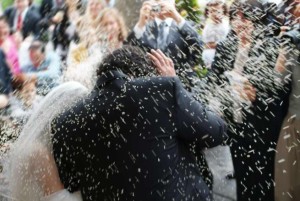Did you ever wonder why the bride traditionally wears a white wedding gown or why she’s supposed to wear something old, new, borrowed, and blue? There are so many wedding traditions, some passed down for centuries and others born just within the last few generations. Different cultures offer varying explanations of many wedding traditions, though a lot of them date back to ancient Roman or Greek times. If you’ve ever wondered why the bride and groom can’t see each other the morning of the wedding or why the bride wears a veil, take a peek at this guide to wedding traditions!
An old item, often on loan from a family member, represents the bride’s past, which in older times meant living with her family up until marriage. The something new represents the couple’s happy future. The borrowed item should come from a happily married person, so that a bit of his or her luck rubs off on the couple’s marriage. Blue represents love and faithfulness–two cornerstones to any happy marriage. In biblical times, blue also represented purity.
Dating back to times when arranged marriages were common, families feared that the groom may change his mind and not want to marry his bride if he saw her in advance. Many modern couples keep the tradition alive to add an element of surprise when the groom sees his bride in her wedding gown for the first time as she walks down the aisle.
This wedding tradition likely dates back to Queen Victoria and Prince Albert’s wedding in 1840. While most brides in those days wore their most expensive gown, she chose a white wedding gown because of her love of lace. Since then, white has been associated with the purity of the bride.
This is another long-standing wedding tradition that dates back centuries. It stems from the ancient Greeks, who believed that a vein directly connected that specific finger to the heart.
Though modern couples often opt for bird seed, bubbles, or other alternatives, for many years it was the norm for guests to throw handfuls of rice over the couple’s heads as they departed from the church. The rice was said to enhance fertility for the young lovers.

This wedding tradition has evolved from one that has existed for over 500 years. In medieval times, guests would vie for a piece of the bride’s wedding gown, believing it would bring them good luck. That meant a bride might end up with a completely shredded gown, so luckily the tradition transformed into a more mellow alternative over time. Now, brides toss their bouquet into the crowd and the lucky lady who catches it is said to be destined for marriage soon thereafter.
Glass-breaking is a standard part of many weddings, especially for Jewish and traditional Italian ceremonies. Tradition claims that the number of pieces into which the glass breaks symbolizes how many years the couple will be happily married.

One of the older wedding traditions still in existence today, this one comes from Ancient Rome. The veil was thought to disguise and protect the bride from evil spirits who may be jealous of her happiness. Some historians trace this tradition back to the days of arranged marriages as well, with the veil keeping the groom from really seeing his bride until after they had exchanged vows.
8 Wedding Traditions Explained